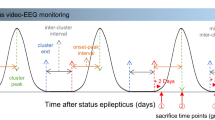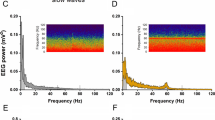Abstract
Our previous study on proteomic analysis has shown that clusterin (CLU) is significantly decreased in the cerebrospinal fluid (CSF) of patients with epilepsy. Therefore, the present study aimed to confirm CLU concentration reduction in the CSF of patients with drug-resistant epilepsy and drug-responsive epilepsy. Fifty-two patients with epilepsy (23 drug resistance and 29 drug effectivity) and 20 control individuals were recruited. The concentrations of CSF and serum CLU were detected. Moreover, alteration of CLU was detected in the rat hippocampus over time after pilocarpine-induced status epilepticus (SE). Our results showed that human CSF-CLU levels were decreased in patients with both drug-resistant epilepsy and drug-responsive epilepsy compared to controls, and concentration of CSF-CLU was obviously lower in drug-resistant epilepsy than in drug-responsive epilepsy. In the pilocarpine-induced seizure rats, expression of neuronal CLU was gradually decreased in a time-dependent manner from acute phase to chronic phase after the onset of SE. In conclusion, CLU level is decreased in the CSF of human epilepsy and the similar alteration is confirmed in a rat model with epilepsy. Therefore, CLU might contribute to the development of epilepsy and be a potential CSF biomarker for resistant epilepsy.




Similar content being viewed by others
References
Bettuzzi S (2009) Chapter 1: introduction. Adv Cancer Res 104:1–8
Bettuzzi S, Rizzi F (2009) Chapter 5: nuclear CLU (nCLU) and the fate of the cell. Adv Cancer Res 104:59–88
Blaschuk O, Burdzy K, Frotz IB (1983) Purification and characterization of cell-aggregating factor (clusterin), the major glycoprotein in ram rete testis fluid. J Biol Chem 258:7714–7720
Charnay Y, Imhof A, Vallet PG, Kovari E, Bouras C, Giannakopoulos P (2012) Clusterin in neurological disorders: molecular perspectives and clinical relevance. Brain Res Bull 88:434–443
Dragunow M, Preston K, Dodd J, Young D, Lawlor P, Christie D (1995) Clusterin accumulates in dying neurons following status epilepticus. Brain Res Mol Brain Res 2:279–290
Engel T, Sanz-Rodgriguez A, Jimenez-Mateos EM, Concannon CG, Jimenez-Pacheco A, Moran C, Mesuret G, Petit E, Delanty N, Farrell MA, O'Brien DF, Prehn JH, Lucas JJ, Henshall DC (2013) CHOP regulates the p53-MDM2 axis and is required for neuronal survival after seizures. Brain 136:577–592
Fritz IB, Burdzy K, Setchell B, Blaschuk O (1983) Ram rete fluid contains a protein (clusterin) which influences cell–cell interactions in vitro. Biol Reprod 28:1173–1188
Henshall DC, Engel T (2013) Contribution of apoptosis-associated signaling pathways to epileptogenesis: lessons from Bcl-2 family knockouts. Front Cell Neurosci 7:110
Kim N, Choi WS (2011) Proapoptotic role of nuclear clusterin in brain. Anat Cell Biol 44:169–175
Kim JH, Kim JH, Yu YS, Min BH, Kim KW (2010) Protective effect of clusterin on blood-retinal barrier breakdown in diabetic retinopathy. Invest Ophthalmol Vis Sci 51:1659–1665
Kim YS, Choi MY, Ryu JH, Lee DH, Jeon BT, Roh GS, Kang SS, Kim HJ, Cho GJ, Choi WS (2012) Clusterin interaction with Bcl-xL is associated with seizure-induced neuronal death. Epilepsy Res 99:240–251
Klock G, Markus Baiersdoerfer M, Koch-Brandt C (2009) Chapter 7: cell protective functions of secretory Clusterin (sCLU). Adv Cancer Res 104:115–138
May PC, Finch CE (1992) Sulfated glycoprotein 2: new relationship of this multifunctional protein to neurodegeneration. Trends Neurosci 15:391–396
Meldrum BS (2002) Concept of activity-induced cell death in epilepsy: historical and contemporary perspectives. Prog Brain Res 135:3–11
Michel D, Chabot JG, Moyse E, Danik M, Quirion R (1992) Possible functions of a new genetic marker in central nervous system: the sulfated glycoprotein-2 (SGP-2). Synapse 11:105–111
Nilselid AM, Davidsson P, Nägga K, Andreasen N, Fredman P, Blennow K (2006) Clusterin in cerebrospinal fluid: analysis of carbohydrates and quantification of native and glycosylated forms. Neurochem Int 48:718–728
Nizard P, Tetley S, Le Drean Y, Watrin T, Le Goff P, Wilson MR, Michel D (2007) Stress-induced retrotranslocation of clusterin/ApoJ into the cytosol. Traffic 8:554–565
Oby E, Janigro E (2006) The blood-brain barrier and epilepsy. Epilepsia 47:1761–1774
Okamoto OK, Janjoppi L, Bonone FM et al (2010) Whole transcriptome analysis of the hippocampus: toward a molecular portrait of epileptogenesis. BMC Genomics 11:230
Park S, Mathis KW, Lee IK (2013) The physiological roles of apolipoprotein J/clusterin in metabolic and cardiovascular diseases. Rev Endocr Metab Disord. doi:10.1007/s11154-013-9275-3
Poon S, Easterbrook-Smith SB, Rybchyn MS, Carver JA, Wilson MR (2000) Clusterin is an ATP-independent chaperone with very broad substrate specificity that stabilizes stressed proteins in a folding competent state. Biochemistry 39:15953–15960
Racine RJ (1972) Modification of seizure activity by electrical stimulation. II. Motor seizure. Electroencephalogr Clin Neurophysiol 32:281–294
Schreiber SS, Tocco G, Najm I, Baudry M (1993) Seizure activity causes a rapid increase in sulfated glycoprotein-2 messenger RNA in the adult but not the neonatal rat brain. Neurosci Lett 153:17–20
Seifert G, Schilling K, Steinhauser C (2006) Astrocyte dysfunction in neurological disorders: a molecular perspective. Nat Rev Neurosci 7:194–206
Suzuki T, Tozuka M, Kazuyoshi Y, Sugano M, Nakabayashi T, Okumura N, Hidaka H, Katsuyama T, Higuchi K (2002) Predominant apolipoprotein J exists as lipid-poor mixtures in cerebrospinal fluid. Ann Clin Lab Sci 32:369–376
Wiggins AK, Shen PJ, Gundlach AL (2003) Delayed, but prolonged increases in astrocytic clusterin (ApoJ) mRNA expression following acute cortical spreading depression in the rat: evidence for a role of clusterin in ischemic tolerance. Brain Res Mol Brain Res 114:20–30
Wilson MR, Easterbrook-Smith SB (2000) Clusterin is a secreted mammalian chaperone. Trends Biochem Sci 25:95–98
Xiao F, Chen D, Lu Y, Xiao Z, Guan LF, Yuan J, Wang L, Xi ZQ, Wang XF (2009) Proteomic analysis of cerebrospinal fluid from patients with idiopathic temporal lobe epilepsy. Brain Res 1255:180–189
Zhang H, Kim JK, Edwards CA, Xu Z, Taichman R, Wang CY (2005) Clusterin inhibits apoptosis by interacting with activated Bax. Nat Cell Biol 7:909–915
Acknowledgments
This study was supported by grants from the National Natural Science Foundation of China (81201002); the Key Project of Chinese Ministry of Education (210182); Natural Science Foundation Project of Chongqing Science and Technology Commission (cstc2013jcyjA10013); the Key Project of Chongqing Municipal Health Bureau (2012-1-010); Scientific and Technological Research Program of Chongqing Municipal Education Commission (KJ120302); and College of Basic Medicine of Chongqing medical University (201315).
Conflict of Interest
The authors have no conflicts of interest to declare.
Author information
Authors and Affiliations
Corresponding author
Additional information
Weihua Yu and Dan Chen contributed equally to this manuscript.
Rights and permissions
About this article
Cite this article
Yu, W., Chen, D., Wang, Z. et al. Time-Dependent Decrease of Clusterin as a Potential Cerebrospinal Fluid Biomarker for Drug-Resistant Epilepsy. J Mol Neurosci 54, 1–9 (2014). https://doi.org/10.1007/s12031-014-0237-3
Received:
Accepted:
Published:
Issue Date:
DOI: https://doi.org/10.1007/s12031-014-0237-3




